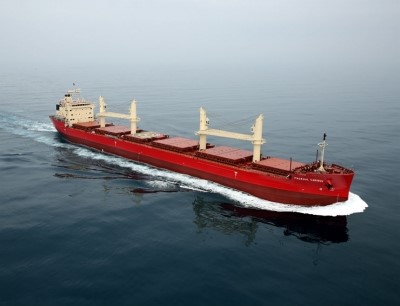Last August, an ocean-going laker set precedent as it entered the Port of Indiana-Burns Harbor, which is located on Lake Michigan. The Federal Caribou is equipped with a ballast water treatment system (BWTS), a first for ships transiting the Great Lakes.
According to Montreal-based bulk ship owner Fednav, its Federal Caribou protects the Great Lakes from potentially harmful invasive species by treating its ballast water two times: by conducting an exchange in the North Atlantic, and through filtration and a chlorine disinfection treatment on the ship.
"This is a pivotal step in protecting the Great Lakes against invasive species and preserving biodiversity in the region,"
says Paul Pathy, president and co-CEO of Fednav Limited. "Fednav is proud to be the first shipping company to deploy such systems, and we are pleased that the Federal Biscay is serving as a test ship for this technology."
DISCHARGE OF UNTREATED BALLAST WATER POLLUTES
The word “ballast" derives from an early Dutch word meaning “useless load." Despite its unflattering etymology, ballast, as it applies to ballast water, has a rightful place in the maritime industry. Ballast water stabilizes ocean-going vessels when they're not fully loaded, and helps maintain stress loads.
But the road to perdition is sometimes paved with good intentions, as someone wise once said, probably a mariner himself. Unfortunately, ballast water contains a variety of organisms including bacteria and viruses, and the adult and larval stages of many marine and coastal plants and animals. While most of the organisms won't survive to the point at which the ballast is discharged, some may survive, and even thrive, in their new environment.
The invasion of non-native species into new environments via ships’ ballast water has become one of the most severe pollution problems facing the world’s waterways and ports. For example, since the St. Lawrence Seaway connecting the Great Lakes to the Atlantic Ocean was opened in 1959, more than 185 aquatic invasive species have entered the Great Lakes, including zebra mussels and quagga mussels. You won't find these kind of mussels on any seafood menu.
According to the
National Wildlife Federation, "the invasive species disrupt the food chain, foul beaches and damage infrastructure—costing citizens, industry and businesses at least $200 million per year. Most of these species were transported into the Great Lakes in the ballast water tanks of ocean-going ships."
IMO ENACTS PRESENT AND FUTURE REMEDIES FOR CLEANER WATER
But it's a global issue, as well, and the International Maritime Organization adopted the
Ballast Water Management Convention in 2004 to prevent the spread of harmful aquatic organisms from one region to another. The Convention establishes standards and procedures for the management and control of ships' ballast water and sediments.
Under the Convention, all ships in international traffic are required to manage their ballast water and sediments to a certain standard, according to a ship-specific ballast water management plan. All ships will also have to carry a ballast water record book and an international ballast water management certificate.
The ballast water management standards will be phased into full force in 2017. Until then, as an intermediate solution, ships should exchange ballast water mid-ocean. However, eventually most ships will need to install an on-board ballast water treatment system.
BWTS WORKS IN BOTH FRESH AND SALT WATERS
Since 1993 ocean-going ships bound for the Great Lakes have been required to replace their ballast water with ocean water, a process known as ballast water exchange.
Fednev's Federal Caribou, destined to ship general cargo to the Great Lakes and bulk commodities like grain from the Midwest to world markets, features a BallastAce System.
Developed by
JFE Engineering Corporation, the BallastAce system operates through a sophisticated filter and sodium hypochlorite (bleach) injection mechanism in Federal Caribou's ballast system, in both fresh and salt waterways.
Federal Caribou is one of Fednav's seven new lakers equipped with BWTS. The ships also offer:
- 25% fewer greenhouse gas emissions than similar vessels built less than 15 years ago
- A decrease of over 15% nitrogen oxide emissions
- A CLEAN notation from the DNV/GL classification society




